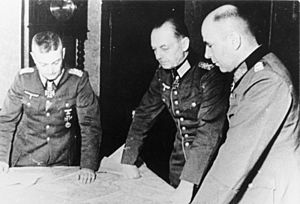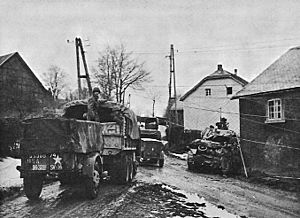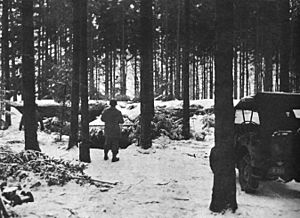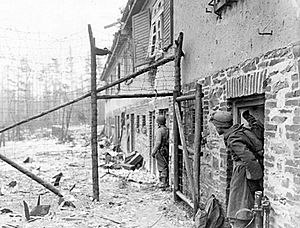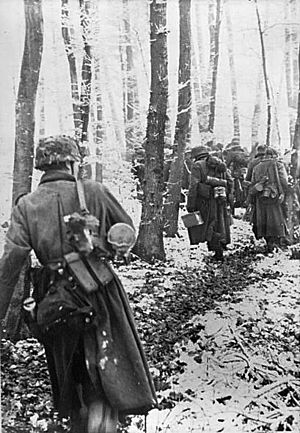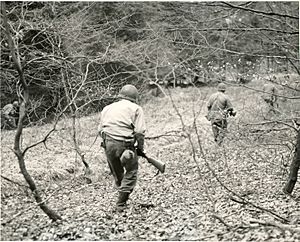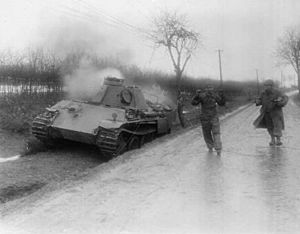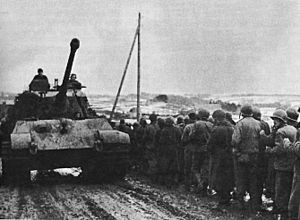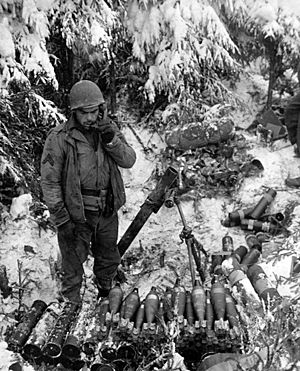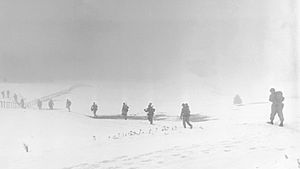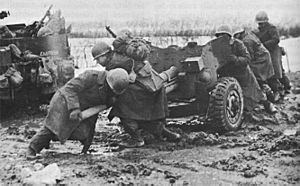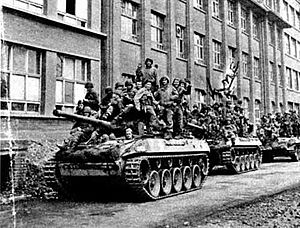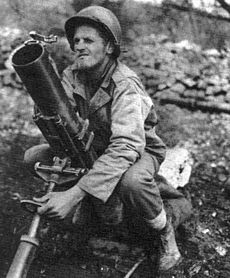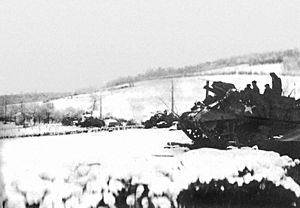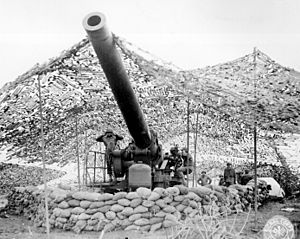Battle of Elsenborn Ridge facts for kids
Quick facts for kids Battle of Elsenborn Ridge |
|||||||
|---|---|---|---|---|---|---|---|
| Part of the Battle of the Bulge | |||||||
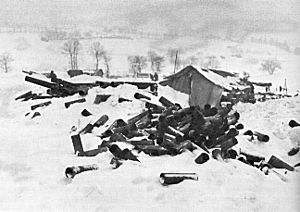 Discarded artillery shell casings litter a U.S. artillery position on Elsenborn Ridge. |
|||||||
|
|||||||
| Belligerents | |||||||
| Commanders and leaders | |||||||
|
|
||||||
| Units involved | |||||||
|
|||||||
| Strength | |||||||
| 38,000 men initially, increasing to >80,000 | 56,000 men initially | ||||||
| Casualties and losses | |||||||
|
|
||||||
The Battle of Elsenborn Ridge was a key part of the Battle of the Bulge during World War II. It took place from December 16 to 26, 1944. This battle was fought in the Ardennes region of Belgium, specifically around Elsenborn Ridge. This area was the only part of the American front line where the German army failed to advance during the entire Battle of the Bulge.
The Germans aimed to capture important roads through this area to reach the city of Antwerp. This would have split the American and British armies. Adolf Hitler, Germany's leader, believed this attack would make the Allies want to make peace. He sent his best armored units to this area.
The American forces, including the new 99th Infantry Division, were spread out. They thought this area would be quiet. However, the Germans launched a surprise attack. The battle was very intense, lasting ten days. American and German lines were often very close. The Americans used strong defenses and powerful artillery to stop the German advance.
Contents
The German Plan for the Ardennes
The German plan, called Unternehmen Wacht am Rhein (Watch on the Rhine), was a big surprise attack. Hitler told his generals about it on September 16, 1944. The goal was to break through the American lines quickly. They wanted to reach the Meuse River and then capture the port of Antwerp.
Capturing Antwerp would cut off Allied supplies and divide the American and British armies. Hitler hoped this would force the United States and Britain to make peace. His generals thought the goal was too ambitious, but Hitler insisted. The Germans planned to attack through the Losheim Gap in Belgium, just as they had in 1914 and 1940.
German Army's Strength
Hitler chose his best troops and trusted officers for this attack. The main force was the 6th Panzer Army, led by Sepp Dietrich. This army was given the best supplies and equipment. It had over 1,000 artillery pieces and 90 Tiger tanks, making it a very powerful force.
The 6th Panzer Army included elite Waffen-SS units. It had four armored divisions (called panzer divisions) and seven infantry divisions. Many of the infantry units were volksgrenadier units. These were new units made up of young boys, older men, and soldiers returning from injuries. They were often led by experienced veterans.
The German plan relied on having many more troops than the Americans at the breakthrough points. They hoped to overwhelm the Americans and reach the Meuse River in just three days.
German Troop Positions
The German troops near Monschau were part of the LXVII Armeekorps. This corps was placed under the command of the 6th Panzer Army for the attack. Their job was to secure the northern side of the 6th Panzer Army's advance. They would block roads leading into the area from the north and west.
South of the LXVII Armeekorps was the I SS Panzer Corps. This corps included elite units like the 1st SS Panzer Division and the 12th SS Panzer Division. Their main job was to break through the American lines and reach the Meuse River and then Antwerp. The 12th SS Panzer Division was made up of young soldiers from the Hitler Youth.
The Germans planned to use specific routes, called rollbahns, to move their tanks quickly. Rollbahn A and B were planned to go through Elsenborn and nearby villages. Their first goal was to break through the lines of the inexperienced 99th Infantry Division and the battle-hardened 2nd Infantry Division. After breaking through, they needed to capture Elsenborn Ridge to control the roads.
The plan also included Operation Stößer, where German paratroopers would drop behind American lines. Their goal was to capture key crossroads before the main German forces arrived.
American Defense Positions
Monschau, in the northern part of the German attack, was a very important target. A main road from Monschau led to Eupen, where the American V Corps headquarters was located. This road also continued to Liège, where the First Army headquarters was. These cities had large supply depots.
On December 16, the only unit guarding the highway to Eupen was the 38th Cavalry Reconnaissance Squadron. The 99th Infantry Division was positioned in towns and forests east and south of Elsenborn Ridge. This division had not yet seen combat. Their troops were spread very thin over a 22-mile front. Each regiment had to protect about 7 miles of front, which was much wider than recommended. There were no reserve units.
Despite being new to combat, the 99th Infantry Division built strong defenses. They set up good communication lines, placed weapons carefully for overlapping fire, and sent out patrols. They also planned their artillery support well, aiming at likely enemy paths. By mid-December, the troops were well dug in with barbed wire and trip flares. The weather was very cold, with snowstorms starting on December 16.
Battle of Heartbreak Crossroads
Before the main German attack, the experienced 2nd Infantry Division was fighting to capture a crossroads near the Siegfried Line. This was part of the larger Battle of the Hurtgen Forest. On December 14, American soldiers found a way through German defenses. By December 16, they had captured the crossroads and nearby roads. However, they didn't have enough explosives to destroy the German bunkers.
The German Attack Begins
On the morning of Saturday, December 16, a snowstorm covered the forests. The temperature dropped to 10°F (-12°C). The German attack began with a huge artillery bombardment just before 5:30 AM. American commanders first thought it was just a small counter-attack. But large numbers of German infantry followed the barrage and attacked.
The main attack in the north was led by the I SS Panzer Corps. The 1st SS Panzer Division was the spearhead, led by Joachim Peiper's kampfgruppe (battle group). This group had 4,800 men and 600 vehicles, including many powerful tanks like Panthers and Tiger IIs.
The German 277th Volksgrenadier Division was supposed to capture Krinkelt-Rocherath. Most of these soldiers were inexperienced. The Germans used searchlights to light up the clouds, helping their infantry see. But this also made the German troops easy targets for the Americans. The American troops in the front lines were quickly overrun or captured.
However, the Germans faced problems right away. A bridge they needed to cross had been destroyed by the Americans. German engineers were slow to repair it. An alternative route couldn't hold the weight of their tanks. Peiper's forces were delayed by mines and mine-clearing operations.
German Advance Delayed at Lanzerath
The small village of Lanzerath was on a key road. It was defended by only 18 American soldiers from a reconnaissance platoon, led by 20-year-old Lieutenant Lyle Bouck. These few men, along with four artillery observers, were left alone to hold the line.
In a 20-hour battle, this small American platoon caused about 93 German casualties. They greatly slowed down the entire German Sixth Panzer Army's attack schedule. The whole platoon was eventually captured. Years later, they received a special award called the Presidential Unit Citation. Every member of the platoon was decorated, making it the most decorated platoon of World War II.
Fighting Near Monschau and Höfen
The U.S. 3rd Battalion, 395th Infantry Regiment, was positioned near Monschau and Höfen. On December 16, their positions were hit by heavy artillery and rocket fire. All communication lines were cut. Twenty minutes after the barrage, German infantry attacked at five points. The Germans outnumbered the Americans five to one and sometimes surrounded them.
The Americans fought back with machine guns, rifles, mortars, and hand-to-hand combat. They stopped the German advance. American artillery, once communications were restored, also pounded the attacking Germans. This was the only part of the American front line in the Battle of the Bulge where the Germans failed to advance. By the end of the day, 104 Germans were killed, and 160 were wounded. The American battalion lost only four killed.
General Lauer, commander of the 99th Division, ordered his troops to hold their positions. Later, they were told to withdraw to a crossroads near Rocherath-Krinkelt to set up a roadblock. This defensive line was meant to protect the high ground of Elsenborn Ridge. Many scattered American troops gathered at Elsenborn Ridge, and organizing them into a strong defense was a huge task.
German Paratrooper Drop Fails
The German Operation Stößer was a plan to drop paratroopers behind American lines. Their goal was to seize key crossroads. However, the operation was a complete failure. Most of the paratroopers were inexperienced, and the pilots were new. They took off on the night of December 16-17 into strong winds and snow.
It was the only nighttime paratrooper drop by the Germans in World War II. Many paratroopers landed far from their target, some even behind German lines or still in their planes. Only a few hundred landed near the right spot. Strong winds made landings difficult, and many paratroopers were injured or died.
The scattered drops confused the Americans, who thought a much larger force had landed. This made the Americans send troops to secure their rear, instead of focusing on the main German attack at the front. By noon on December 17, the German paratrooper leader had only gathered about 300 men. They were too few to take their objective.
The Battle Continues
December 17: Fierce Fighting
The main German attack on Elsenborn Ridge began on the morning of December 17. Tank and panzergrenadier units of the 12th SS Panzer Division led this assault. After heavy fighting in the woods, the 277th Volksgrenadier Division overran American forward positions. By 11:00 AM, the 99th Infantry Division was pushed back into Rocherath-Krinkelt.
The German attack quickly stalled against heavy American machine gun fire. The dense woods and thick brush also slowed them down. American artillery responded quickly, firing on the exposed Germans. American tanks from the 741st Tank Battalion and tank destroyers also helped hold back the German advance in Rocherath-Krinkelt.
The 1st Infantry Division, which had been resting, quickly moved to the southern end of the 99th's line near Bütgenbach. Troops from the 1st and 9th Infantry Divisions helped strengthen the defenses on Elsenborn Ridge.
Because of the delays, elements of the 1st SS Panzer Division didn't reach the 99th's positions until the afternoon of December 17. Finding their planned route blocked, they were forced to take a more difficult path to the south. Peiper's unit did capture Honsfeld and Büllingen, seizing a large amount of fuel. However, two days into the offensive, Elsenborn Ridge and two of the three main German routes remained under American control.
German commanders became very urgent about capturing Elsenborn Ridge. The American tankers, though outnumbered and facing superior German tanks, fought bravely. They used their smaller, faster Sherman tanks to outmaneuver German Panthers and Tigers, attacking them from the sides or rear.
December 18: Intense Village Fighting
The American withdrawal was made harder by a shortage of ammunition. Luckily, three tank destroyers arrived with bazookas and anti-tank mines. These were crucial when the 12th SS Panzer Division launched a strong tank and infantry attack on Rocherath-Krinkelt. The Americans responded with heavy artillery, mortar fire, bazooka rockets, and anti-tank mines, pushing back the German attack around midnight.
On December 18, German infantry and tanks attacked Rocherath-Krinkelt again. They were supported by powerful Jagdpanther tank destroyers. Both sides pounded the villages with artillery. German tanks and assault guns entered Rocherath-Krinkelt, supported by rockets. The Americans met them with artillery shells that exploded in the air (using "proximity fuses"), and about 20 Sherman tanks.
The narrow streets made it hard for tanks to move. Bazooka rounds fired from rooftops and artillery air bursts created deadly shrapnel. Sherman tanks, hiding in alleys, quickly destroyed six German tanks. Eight more were destroyed by anti-tank guns, rockets, bazookas, and mines. The fighting was very fierce, and losses were heavy on both sides.
American Withdrawal Halted
During the night of December 18-19, some American units were ordered to withdraw from their positions north of Krinkelt. However, the order was a mistake. The commander of V Corps immediately ordered the troops back to their original positions. The American soldiers successfully slipped back into their foxholes before dawn. The Germans did not notice this gap in the lines. If they had, they could have moved behind the 2nd Division, putting the entire unit in danger.
December 19: Germans Shift Attack
On December 19, the Germans decided to shift their main attack south of Elsenborn Ridge. A new tank attack, led by the 12th SS Panzer Division, was launched against Domäne Bütgenbach. The 3rd Panzer Grenadier Division made a frontal attack on Elsenborn Ridge. However, the soft ground in front of the ridge was almost impossible to cross. Many German assault guns got stuck, and the 3rd Panzer Grenadier Division lost 15 tanks that day to American artillery.
In Höfen, about 100 Germans captured four buildings. American rifle and mortar fire couldn't dislodge them. So, the 612th Tank Destroyer Battalion used their 57mm anti-tank guns to fire directly at the buildings. White phosphorus grenades finally forced the remaining 25 Germans to surrender. Seventy-five Germans were found dead in the buildings.
The Americans abandoned the ruined villages of Rocherath-Krinkelt. General Robertson ordered the remaining 2nd Division troops to withdraw to defensive positions on the ridge. Other units also moved to Elsenborn Ridge and fortified their positions. They even had to use dynamite to blast holes in the frozen ground for foxholes.
By the end of the fighting for the villages, five American soldiers earned the Medal of Honor. These included Sgt. Lopez, Sgt. Richard Cowan, Pvt. Truman Kimbro, Sgt. Vernon McGarity, and Sgt William Soderman. Another Medal of Honor was given to Henry F. Warner of the 26th Infantry Regiment.
December 20-22: Final German Attempts
On December 20, the Germans, reinforced by the 12th Volksgrenadier Division, attacked from the south and east. This attack also failed. On December 21, the Germans tried to go around Dom Butgenbach to the southwest. Some German armored units got into Butgenbach, but the 2nd Battalion, with reinforcements, stopped them again.
On December 20, Field Marshal Bernard Law Montgomery took command of all Allied troops north of the German advance. On the same day, the Sixth Panzer Army made several strong attempts to break the American lines. They used artillery, tanks, infantry, and self-propelled guns.
Early on December 21, German Panzergrenadiers attacked the 26th Infantry Regiment's defenses in Dom Butgenbach. The fight lasted all day and night. The Germans broke through several times but were pushed back by American infantry, tank destroyers, and artillery. After the battle, the field was covered with destroyed German tanks and many dead enemy soldiers, some as young as 15 or 16. The Americans had destroyed 47 German tanks.
On December 22, the Germans attacked the right side of Elsenborn Ridge. Again, heavy American artillery fire stopped them. The 26th Infantry Regiment and Sherman tanks played key roles. On December 23, the weather cleared, freezing the ground. This allowed tanks to move freely and for Allied planes to provide air support. The German attack on the 22nd was their last attempt to capture the ridge.
Peiper's forces were stuck in a long column, unable to spread out. He was able to advance about 28 miles west to Stoumont before being stopped. He eventually ran out of fuel and ammunition. On December 24, Peiper abandoned his vehicles and retreated with only 800 men left from his original 4,800.
By December 27, Sepp Dietrich's 6th Panzer Army was in a very difficult situation east of Elsenborn Ridge. The 12th SS Panzer Division and other units were worn out from fighting the strong American positions. They could not advance further. On January 16, 1945, the Sixth Panzer Army was moved to the Eastern Front.
The weather improved in late December and early January, allowing Allied planes to attack the Germans from the air. This greatly slowed their movement. The Battle of the Bulge officially ended on January 16, exactly one month after it began.
Why the Battle Mattered
The organized retreat of the 2nd and 99th Divisions to Elsenborn Ridge and their strong defense stopped the 6th Panzer Army. This blocked the Germans from reaching key roads in northern Belgium that they needed to get to Antwerp. It was the only part of the American front line during the Battle of the Bulge where the Germans failed to advance.
Historian John S.D. Eisenhower said that the actions of the 2nd and 99th divisions on the northern side were "the most decisive of the Ardennes campaign." The Germans were denied access to three of their five planned routes. This forced them to change their plans, greatly slowing their advance in the north. This success allowed the Americans to move freely and effectively on the northern side of the German attack.
Liège, a major American supply center, was only 20 miles from Spa. If the Germans had captured this area, the outcome of the battle might have been different. General Courtney Hodges, commander of the First U.S. Army, praised the 2nd Division, saying their actions would "live forever in the history of the United States Army."
After the war, German General Hasso von Manteuffel said that the German attack "failed because our right flank near Monschau ran its head against a wall." The battle showed that teamwork and strong defense could stop even the most powerful attacks.
High Costs for Both Sides
The fighting was intense and costly for both sides. However, the German losses were much harder to replace. While the exact number of German casualties is not known, they lost many tanks. The American 2nd and 99th Infantry Divisions' losses are known.
Small American units often fought independently, launching fierce counterattacks and holding strong defenses. This frustrated the Germans' plans for a quick advance and messed up their timetable. By December 17, German planners knew they would not take their objectives at Elsenborn Ridge as planned.
The 99th Division caused huge losses to the attacking German volksgrenadier units. The 99th lost about 20% of its strength, including 465 killed. This strong defense prevented the Sixth Panzer Army from going around Elsenborn Ridge. The 99th Division received many awards and citations for its performance.
Media Attention
Even though the Americans had a big success at Elsenborn Ridge, other parts of the Battle of the Bulge got more attention from the news. This was partly because Bastogne was a popular place for war reporters to rest. The quick German advance that surrounded Bastogne, the dramatic air resupply, and General Patton's fast actions all captured the public's imagination. These stories were featured in newspapers and on the radio.
However, there were no reporters in the areas of Saint-Vith, Elsenborn, or Monschau. The public was less interested in the steady, stubborn resistance of the troops in the north.
Weapons and Fighting Styles
German Combined Arms Tactics
The German attack relied on their newest weapons and armored vehicles. Early in World War II, the German army was famous for its "Blitzkrieg" (lightning war) tactics. This involved fast, combined attacks using tanks, infantry, and air support. Later in the war, Germany developed advanced tanks like the Tiger II, Panther, and Jagdpanther. These tanks had powerful cannons and thick armor, making them superior to most American vehicles. However, these advanced tanks were few in number and often broke down.
These units were supported by new rocket artillery units. While not very accurate, these rockets could cover a large area with explosions. German infantry also had the new Sturmgewehr 44, the world's first mass-produced assault rifle. They also used the Panzerfaust 100, an improved anti-tank rocket that could penetrate any American tank armor.
German tactics for the attack involved a strong artillery barrage first. Then, infantry from the volksgrenadier divisions would attack, supported by light assault guns. This initial attack was meant to clear roads for the SS panzer divisions. These tank divisions would then quickly move to capture bridges and drive to Antwerp. The Germans expected to overwhelm the Allies with speed and surprise. However, Hitler did not consider the narrow, winding roads of the northern Ardennes. He also underestimated the American units there.
American Innovations and Tactics
The American defense relied on strong fortifications, clever use of light anti-tank weapons like the bazooka and anti-tank mines, and powerful artillery support. American tanks and anti-tank guns were often not as effective against the newer German tanks. However, they used improved cannons on their Sherman tanks and M18 Hellcat tank destroyers. The British also developed special high-velocity anti-armor ammunition for the 57mm anti-tank cannon, which Americans eagerly traded for. The Americans also used 90mm anti-aircraft guns as anti-tank cannons, mounted on tank destroyer vehicles like the M36 Jackson.
After the Normandy landings, the American army learned from its losses against German tank attacks. American tactics began to include "defense in depth." This meant using mobile cavalry units with light tanks to screen defensive positions. When attacked, these units would delay the Germans, then retreat through main defensive lines. These main lines were built around choke points like villages and bridges. Machine gun and infantry positions were protected by barbed wire and minefields. They also used "daisy chains" of mines, which were lines of mines that could be pulled across a road. This defensive line was supported by bazooka teams in buildings, dug-in anti-tank guns, and tank destroyers firing from hidden positions.
The Role of Artillery
As German units approached American defenses, the Americans used their excellent communication and artillery tactics. One tactic was "time on target," where many artillery pieces, even far from the battle, would fire so that all their shells hit the target at the same time. This allowed them to concentrate huge firepower on attacking German units.
A new invention, the artillery proximity fuse, was also used. These fuses were developed in 1942 and made shells explode before hitting the ground, maximizing the shrapnel effect. This was very effective against infantry. Near Monschau, an American colonel ignored orders and used these fuses, which greatly helped stop the German attack.
The American Army also had plenty of self-propelled artillery and ammunition. When used well, these attacks canceled out the advantage of superior German tanks. General George S. Patton said that the proximity fuse changed how land warfare was fought.
The American defense also had strong air support from P-47 Thunderbolt fighter bombers. These planes, called "flying tanks," fired rockets that were very effective against the thinly armored tops of German tanks. Snowstorms prevented these planes from being used until the weather cleared on December 23.
Lasting Impact
Medal of Honor Heroes
Several American soldiers earned the Medal of Honor for their bravery during this battle:
- Pfc José M. López, a machine gunner, for his courage during a fighting retreat.
- Sgt Richard Cowan, who killed about one hundred enemy soldiers while covering his unit's retreat.
- T/5 Sgt Vernon McGarity, who, despite being wounded, led his squad, rescued wounded men, and attacked Germans.
- Pvt Truman Kimbro, who, though wounded, successfully laid mines across a road under fire before being killed.
- Sgt William A. Soderman, who faced German tanks three times and destroyed the lead tank with a bazooka, allowing his comrades to retreat.
- Cpl Henry F. Warner (awarded posthumously), who single-handedly disabled several German tanks near Bütgenbach.
Memorials
Several monuments have been built to remember the Battle of Elsenborn Ridge. Besides those below, there are memorials in Ligneuville, Stavelot, Stoumont, and near Cheneaux at the Neufmolin Bridge.
See also


